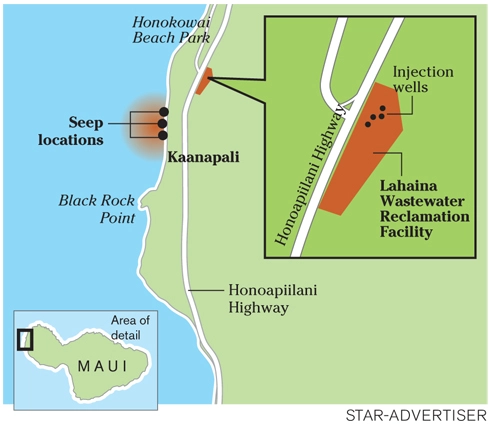Honolulu Star Advertiser | August 11, 2013
By Gary T. Kubota
Waste water from a Maui sewage plant is killing Kaanapali reefs, studies find
Maui resident Lance Collins remembers more than 20 years ago swimming as a youth in waters off the old airport beach in north Kaanapali before the reef began to change for the worse.
“There was a lot more reef fish,” he said. “The reef in terms of color just looked more alive, vibrant white as opposed to dead bone white.”
Collins says environmental and community groups are close to solving and stopping a major source of ocean pollution in north Kaanapali as federal scientific findings confirm waste water from a Maui County sewage treatment plant is flowing underground into nearshore waters.
He said studies have tied the excessive nutrients from the sewage to algae blooms that have been killing the reefs.
A lawsuit filed in 2012 in U.S. District Court sought to halt the county’s practice of injecting millions of gallons of treated sewage into deep wells at the waste water treatment plant in Lahaina.
The lawsuit said the county receives about 4 million gallons of sewage a day and what it can’t sell for re-use after treatment is injected into the wells.
The groups filing the lawsuit include Maui Tomorrow, the Surfrider Foundation, Sierra Club-Maui Group, and the West Maui Preservation Association.
Earthjustice attorney David Henkin, representing the groups, said Friday he was in settlement talks with the county but declined further comment.
The county has also declined comment.
For more than 20 years and through Republican and Democratic mayoral administrations, Maui County has argued that there was no connection between the sewage injection wells and nearby ocean problems, including algae blooms and dead coral.
During a resort building boom in the early 1990s, then-Maui Mayor Linda Lingle’s administration proposed expanding the number of injection wells from four to 12 at the plant.
Resistance from federal officials forced the county to turn to treating and redirecting waste water for irrigation purposes at golf courses.
Major algae blooms occurred in the north Kaanapali area in the early 2000s.
In 2009, the state Department of Land and Natural Resources banned catching certain kinds of herbivore fish in waters off Kahekili Beach Park and other parts of north Kaanapali, in hopes that an increase in the number of fish could control the algae and create a healthier reef environment.
A Lahaina Groundwater Tracer Study, released in June, showed tracer dyes put into the injection wells at the waste water treatment plant eventually rose up in seepage holes from submarine springs in north Kaanapali.
Collins, the spokesman for the West Maui Preservation Association, said earlier University of Hawaii studies showed the algae blooms were associated with the excessive presence of nutrients associated with sewage but the county argued the source could be from fertilizer from golf courses and other ground runoff.
Collins said the study in June proves the county has been illegally discharging waste water into the ocean from its Lahaina treatment facility’s injection wells.
“The study confirms what we’ve been saying for years,” he said.
Collins said the recent study puts a different perspective on free-diving in waters off Kahekili Beach.
“It’s a beautiful place,” he said. “You can find warm underwater springs. If you know what it is, you feel like you shouldn’t be in the water.”
Original article URL: https://www.staradvertiser.com/2013/08/11/hawaii-news/ocean-pollution-traced-to-county/

